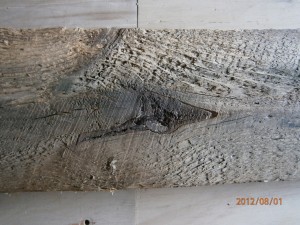When I started out working wood, I used only ‘perfect’ boards. Straight grain, knot free, smooth-planed wood. Nice stuff. The first time I stepped ‘out of the box,’ I needed a board to enclose the lights above the kitchen sink in Westford and the only board I had, had a big ugly knot hole smack dab in the middle of it. I used it anyway.
Reclaimed wood is full of defects. We’re trained to think: “Straight grain: good. Blemish: bad.” It takes a ‘queer eye’ to see that the boards with the old peg or nail or knot holes are the best ones in the pile. Or to save the board with the long, crooked crack for your most prominent panel. When I met Mary, she was full of stories about her clients using her Tung Oil on reclaimed wood. I’d still never heard of it, and if I had, I probably thought it was a gimmick. When I got involved in her kitchen remodel back in ’04, she insisted on using reclaimed timber. I was skeptical, but I signed up anyway. The cabinets came out great: the cracks, nail holes, and saw marks made every panel unique.
Most reclaimed wood comes from old buildings. When I renovated my first fixer-upper in Winooski in ’81, I started off by gutting the inside, and I couldn’t believe the crappy old posts and beams it was made of. I ripped a bunch of them out and replaced them with good old modern 2-by’s. I put the beams in a pile in the back yard with a ‘free’ sign on it, and some lucky guy burned them the next winter. This was before anyone thought to re-use old wood, and I just didn’t know any better.
There are those who claim that using reclaimed timber is the Green thing to do. You know: “reduce reuse recycle.” This is nonsense. It’s not Green when you’re using up scarce, non-renewable resources, and there aren’t a lot of things which are as scarce and non-renewable as reclaimed wood. This stuff comes from barns that have been standing for 100 years, and how many of Those are they still making? It comes from logs which sank to the bottom of the river during a 19th century logjam. It comes from 12 ft tall barrels in an old pickle factory. It’s a lot of work to remove all the square nails in an old floor. Or to salvage those muddy logs, dry them out, and cut them up. Or to get rid of that pickle smell.
Which is why: it’s expensive stuff, and you’ll pay $20/bf and up. What you’re paying for is scarcity and labor, of course, but also age and color and character. Two hundred years ago, they were cutting down old-growth trees to make floors and beams and ships. Today, you can’t even find an old growth tree, and if you did, you might go to jail for cutting it down.
When Mary and I first started planning our new house, she fast-forwarded straight to the woodwork, and wanted to use reclaimed wood. Everywhere. “Oh gawd,” I said: “we can’t afford that!” If we’re lucky, we’ll be able to afford paint! But we don’t seem to do anything like normal people, and the way our project was planned was: sell my house, move into the Green house (a fixer-upper) on her property, build anew further back on the property, and then remove the Green house, re-using what we could. By now, we haven’t really re-used much of anything, but the Green house is a gold mine of old wood, and we’d also saved a lot of wood when we’d taken down part of her old barn a few years past. So it dawned on me that not only could we afford to used reclaimed wood, we almost can’t afford not to. It’s free. Plus labor.

